Chem 2 lab 3 - Study guides, Class notes & Summaries
Looking for the best study guides, study notes and summaries about Chem 2 lab 3? On this page you'll find 360 study documents about Chem 2 lab 3.
Page 2 out of 360 results
Sort by

-
CHEM 103 Lab Exam 1 – Portage Learning
- Exam (elaborations) • 8 pages • 2023
- Available in package deal
-
- $16.49
- 1x sold
- + learn more
CHEM 103 Lab Exam 1 – Portage Learning. What device is used to smother small fires? 1.) beaker 2.) glass is strong combat things like acid and other kinds of harsh stuff. It is neutral with most lab chemicals. 3.) tongs. 4.) watch glass

-
CHEM 103 Lab Exam 2 – Portage Learning
- Exam (elaborations) • 6 pages • 2023
- Available in package deal
-
- $13.99
- 1x sold
- + learn more
CHEM 103 Lab Exam 2 – Portage Learning. The reaction of AgNO with Cu is a single displacement type reaction. During the reaction of AgNO with Cu a blue (color) solution and black/gray (color) solid are formed. 3 3 single displacement

-
CHEM 103 Lab Exam 8 – Portage Learning
- Exam (elaborations) • 8 pages • 2023
-
Available in package deal
-
- $15.49
- 1x sold
- + learn more
CHEM 103 Lab Exam 8 – Portage Learning. Why was warming data used for estimating the freezing/melting point of the cyclohexane? 3. (3 points) How much of the cyclohexane solvent was placed in the test? 1.) molarity 2.) It is considered reliable. It is a dependable predicator of the freezing/melting point of a substnace. it can determine the temperatures when the change occurs.

-
LSU 2024 CHEM 1212 Chemistry Lab Midterm experiment 1 to 20 Louisiana State University
- Exam (elaborations) • 33 pages • 2024
-
- $15.99
- + learn more
LSU 2024 CHEM 1212 Chemistry Lab Midterm experiment 1 to 20 Louisiana State University Experiment 1: Physical and Chemical Properties Experiment 2: Classifying Reactions in the Copper Cycle Experiment 3: Synthesis of Copper II Saccharinate Experiment 4: Limiting Reagent Determination Experiment 5: Citric Acid in Fruit Juices Experiment 6: Vitamin C in Fruit Juices Experiment 7: Investigating Conductivities of Aqueous Solutions and Conductimetric Titration Experiment 8: Determining % Comp...

-
CHEM 103 Lab Exam 4 – Portage Learning
- Exam (elaborations) • 4 pages • 2023
- Available in package deal
-
- $14.49
- 1x sold
- + learn more
CHEM 103 Lab Exam 4 – Portage Learning. Does the following reaction give off heat or absorb heat? Explain briefly. C D H = +263Kcal/mol 3. (4 points) In one experiment in the video, room temperature water was mixed with water at about 38 degrees. To what temperature (about) did the mixture of the two water samples come to after setting for a few minutes? Answer: 1. The heat depends on the amount of substance. If the amount of substance is doubled, then the heat doubles. Other propertie...
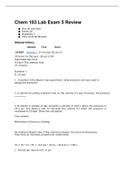
-
Chem 103 Lab Exam 5 Review
- Exam (elaborations) • 5 pages • 2023
-
- $7.99
- 1x sold
- + learn more
Chem 103 Lab Exam 5 Review Question 1 8 / 10 pts 1. (2 points) In the Boyle’s law experiment, what pressure unit was used to gauge the pressure? 2. (2 points) According to Boyle’s law, as the volume of a gas increases, the pressure . 3. (6 points) A sample of gas occupies a volume of 10.5 L when the pressure is 14.3 psi. Use Boyle’s Law to calculate the volume (L) when the pressure is increased to 19.6psi. Show the calculation. Your Answer: Millimeters of mercu...
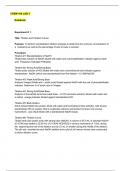
-
CHEM 104 LAB 1, 2, 3, 4, 5, 6, NOTEBOOK STUDY SET LATEST BUNDLE PACK SOLUTION (VERIFIED)
- Package deal • 6 items • 2024
-
- $30.49
- + learn more
CHEM 104 LAB 1, 2, 3, 4, 5, 6, NOTEBOOK STUDY SET LATEST BUNDLE PACK SOLUTION (VERIFIED) CHEM 104 LAB 1, 2, 3, 4, 5, 6, NOTEBOOK STUDY SET LATEST BUNDLE PACK SOLUTION (VERIFIED)
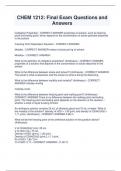
-
Package deal for Chemistry 1212 Lab Final Exam Complete Questions and Answers
- Package deal • 9 items • 2024
-
- $28.49
- + learn more
Chemistry 1212 Lab Final Exam Complete Questions and Answers KSU Chem 1212 Exam 2 Latest Test Questions with 100% Answers KSU Chem 1212 Exam 3 Practice exam Q&A KSU Chem 1212 Exam 4 Test study guide Certification Final Certification for CHEM 1212 Exam 2 Q&A Complete study guide for CHEM 1212 Exam 3 Questions with solutions 100% Chem 1212 Lab Final
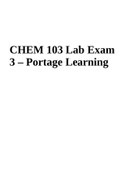
-
CHEM 103 Lab Exam 3 – Portage Learning
- Exam (elaborations) • 3 pages • 2023
-
Available in package deal
-
- $13.99
- 1x sold
- + learn more
CHEM 103 Lab Exam 3 – Portage Learning. A 1.1000 gram hydrate sample chosen from Na2CO3∙10H2O, AlCl3∙6H2O, MgCl2∙6H2O and BaCl2∙2H2O was heated and found to lose 0.5841 gram of H2O. (1) Show the calculation of the % H2O in the unknown hydrate sample. (2) Show the calculation of the % H2O in each of the hydrate compounds and identify the unknown hydrate from the list. Atomic weights: H = 1.008, O = 16.00. MWs: Na2CO3∙10H2O = 286.15, AlCl3∙6H2O = 241.43, MgCl2∙6H2O = 203.301 ...
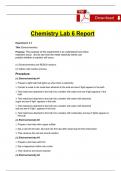
-
CHEM 104 LAB 1, 2, 3, 4, 5, 6, 7, 8, REPORT STUDY SET LATEST BUNDLE PACK SOLUTION (VERIFIED)
- Package deal • 8 items • 2024
-
- $40.49
- + learn more
CHEM 104 LAB 1, 2, 3, 4, 5, 6, 7, 8, REPORT STUDY SET LATEST BUNDLE PACK SOLUTION (VERIFIED) CHEM 104 LAB 1, 2, 3, 4, 5, 6, 7, 8, REPORT STUDY SET LATEST BUNDLE PACK SOLUTION (VERIFIED)

Do you wonder why so many students wear nice clothes, have money to spare and enjoy tons of free time? Well, they sell on Stuvia! Imagine your study notes being downloaded a dozen times for $15 each. Every. Single. Day. Discover all about earning on Stuvia


